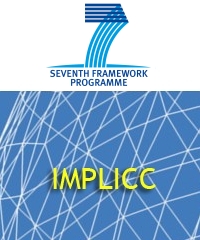IMPLICC - Implications and risks of engineering solar radiation to limit climate change
IMPLICC addressed the call ”Implications and Risks of Novel Options to Limit Climate Change“ within the activity "Climate Change, Pollution and Risks” of the European Union's framework-7 programme (FP7) for research, technological development and demonstration activities (2007-2013). The project was running from July 2009 until September 2012 under the cooperation of 5 higher educational and research institutions in France, Germany and Norway. The overall activities of the project were coordinated by the Max Planck Institute for Meteorology in Hamburg.
Major outcomes of the project are summarized in the "Final report" and a "Synthesis report for policy makers and the interested public".
Many of the numerical climate simulations performed within IMPLICC have followed the GeoMIP (Geoengineering Model Intercomparison Project) protocol. The results of those simulations are available via the Earth System Grid (ESG). For more information on results of the project and ongoing research activities, please contact the project participants.
Brief summary of scientific results
Within the IMPLICC project, five partner institutes from France, Germany and Norway have studied the effectiveness, side effects, risks and economic implications of climate engineering through different solar radiation management techniques suggested to limit climate change. The main tools used in these studies were state-of-the-art numerical Earth system models (in some cases augmented by specific treatments of atmospheric aerosols and chemistry) and an economic model. One central question was what climate would result from the application of three different CE techniques: the reduction of solar irradiance (through space mirrors); the enhancement of the reflection of solar radiation through stratospheric sulfate aerosols; and the manipulation of marine clouds through injection of sea salt. One novel aspect of IMPLICC in the context of climate engineering research was the implementation of a model intercomparison study in order to identify robust climate response patterns.
In an idealized experiment with large greenhouse gas forcing balanced globally by the reduction of solar irradiance it was shown that it may be possible to compensate the increase of global mean temperature. However, the increase in global total precipitation that is expected in scenarios with enhanced greenhouse gas concentrations would be overcompensated by solar radiation management: a geoengineered climate would have less precipitation than a natural climate of the same global mean temperature. The model intercomparison showed that precipitation decreases – under the chosen scenarios - would particularly affect large land masses in the mid-latitudes of the Northern hemisphere, i.e. Canada and the US, central and northern Europe and Asia.
The simulation of a scenario with a much smaller degree of geoengineering, where just the increase of climate forcing through a moderate greenhouse gas emission scenario after the year 2020 would be compensated, showed, not surprisingly, a much smaller climate impact. Because of the weakness of the forcing, the regional patterns of the simulated responses are also less robust than under strong forcing. It was, however, clearly shown that an abrupt termination of climate engineering efforts would lead to very rapid climate change.
The estimation of economic implications of climate change and climate engineering on long time-scales has obvious limitations. However, our simulations suggest that additional climate engineering under a moderate mitigation scenario may not be economically advantageous. This could be different under high-emission scenarios, but also it is then unclear if the economic importance of side-effects would become significant.
IMPLICC has also made progress on microphysical processes involved in the aerosol-based radiation management methods, which help determine their effectiveness. It has become clear that the effectiveness of the methods depends strongly on the implementation, e.g. on the size of emitted sea salt particles. However, uncertainties concerning the amount of aerosol necessary to reach a certain climate effect remain.
It has become clear during the course of the project that some of the remaining uncertainties concerning implications of climate engineering are caused by limited understanding of climate processes in general, which are not necessarily specific to climate engineering. The manipulation of marine clouds, for example, is based on aerosol-cloud interaction processes which are one of the big open questions of climate research, independent of the origin of aerosols. Injecting sulfur into the stratosphere would not only have radiative but also dynamical effects. Dynamical stratosphere-troposphere coupling would need to be better understood in order to fully appreciate the effects of such climate engineering.
Finally, it needs to be noted that the climate response is only one aspect that has to be considered when the implementation of climate engineering techniques is discussed. Other potential side effects specific to some methods, as well as political, ethical, legal and further economic implications have to be taken into account. But the potentially strong climate responses discussed here suggest that climate engineering cannot be seen as a substitute for a policy pathway of mitigating climate change through the reduction of greenhouse gas emissions.
A Statement on geoengineering, its potential uses, costs and side effects as made in the initial phase of IMPLICC can be found here.



